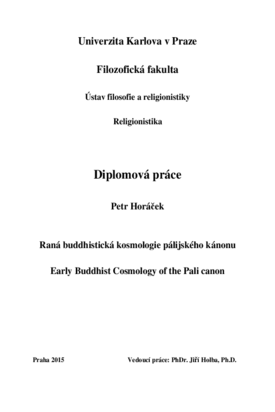Raná buddhistická kosmologie pálijského kánonu
Early Buddhist Cosmology of the Pali canon
diplomová práce (OBHÁJENO)

Zobrazit/
Trvalý odkaz
http://hdl.handle.net/20.500.11956/76037Identifikátory
SIS: 137013
Katalog UK: 990020702950106986
Kolekce
- Kvalifikační práce [24991]
Autor
Vedoucí práce
Oponent práce
Melnikova, Nora
Fakulta / součást
Filozofická fakulta
Obor
Religionistika
Katedra / ústav / klinika
Ústav filosofie a religionistiky
Datum obhajoby
5. 2. 2016
Nakladatel
Univerzita Karlova, Filozofická fakultaJazyk
Čeština
Známka
Výborně
Klíčová slova (česky)
buddhismus, kosmologie, nibbána, asketismus, mniši, pálijský kánon, AgaňňasuttaKlíčová slova (anglicky)
Buddhism, cosmology, Nibbana, ascetism, monks, Pali Canon, AgaññasuttaTato práce pojednává o raně buddhistické kosmologii. Krátce představuje obecné pojetí kosmologie v buddhismu a v pálijském kánonu, aby lépe vynikly charakteristické rysy primárního textu, o který se práce opírá, totiž Agaňňasutty pálijského kánonu. Autor přihlíží i k dalším suttám pálijského kánonu a k sekundární literatuře. Agaňňasutta představuje jeden z prvních kosmologických textů buddhismu a lze ji proto považovat za velmi cenný zdroj informací ohledně raných kosmologických představ a kontextu, ve kterém byly tyto představy vytvářeny. Zabývá se zánikem světa, jeho opětovným projevením, vznikem bytostí, lidí a sociálních vrstev, volbou prvního krále a založením asketických skupin. Pro snadnější orientaci v pramenném materiálu lze děj rozčlenit na dobu do vývoje lidských bytostí, vzniku sociálních institucí s volbou krále a zavedení alternativních sociálních institucí v čele s buddhistickým mnichem. Hlavním cílem práce je ukázat, že Agaňňasutta obsahuje strukturu založenou na nutnosti vzniku lidských bytostí v jejich materiální formě a s jejich morálními chybami, společnosti, která tyto chyby reguluje, a následně transcendence této společnosti buddhistickými mnichy k dosažení nibbány. Při tom autor vychází z dalších interpretací Agaňňasutty v sekundární literatuře badatelů Stanleyho Tambiaha,...
This paper is focused on the early Buddhist cosmology. It briefly presents the general concepts of cosmology in Buddhism and the Pali Canon in order to better emphasize the characteristics of the primary text on which the work is based, namely the Agaññasutta of the Pali canon. The author takes into account other suttas of the Pali canon and secondary literature as well. The Agaññasutta represents one of the first cosmological texts of Buddhism and can therefore be considered as a very valuable source of information about the early cosmological ideas and the context in which these ideas were formed. It deals with the destruction of the world, its re-emergence, the emergence of creatures, human beings and social strata, the election of the first king and the establishment of the ascetic social groups. To gain a better orientation in the source material, the plot can be divided into the period until the development of human beings, the creation of social institutions with the election of the king and the emergence of alternative social institutions headed by a Buddhist monk. The main aim of the present paper is to show that the Agaññasutta contains the structure based on the necessity of the emergence of the human beings in their physical form and endowed with their moral faults, the society which...
